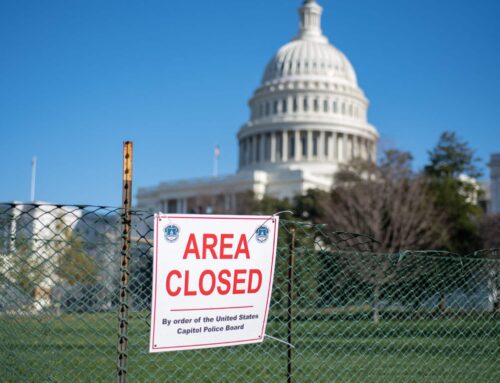In a world where regular order doesn’t exist. And the biggest, baddest, spending bill on the block is an Apex Predator known as “Omnibus”. The earmarks are out there my friends… and they are slippery suckers. By some accounts… the appropriations earmarks in the $1.5 trillion fiscal 2022 omnibus bill that President Joe Biden signed last Tuesday might be perceived as both an exercise in restraint and obfuscation. Joining Steve Ellis to make the podcasting magic happen is a bona fide forensic earmarkist – TCS Senior Policy Analyst – Josh Sewell.
Listen here or on Apple Podcasts
Episode 18 – Transcript
Steve Ellis:
Welcome to all American taxpayers seeking common sense. You’ve made it to the right place. For over 25 years. TCS that’s Taxpayers for Common Sense has served as an independent nonpartisan Budget Watchdog group based in Washington, D.C. We believe in fiscal policy for America, that is based on facts. We believe in transparency and accountability because no matter where you are on the political spectrum, no one wants to see their tax dollars wasted. And that dear podcast listeners is why we’re committed to monitoring earmarks. I say it at the end of every episode, and today I’m starting with it. Why? Because in a world where regular order doesn’t exist, the biggest baddest spending bill on the block is the apex predator known as the “Omnibus”. The earmarks are out there, my friends and they are slippery little suckers. So it should be no surprise that this episode omnibus and earmarks, oh, my is coming to you right now and here to make that podcasting magic happen is a bonafide forensic earmark TCS senior policy analyst, Josh Sewell.
Josh Sewell:
Hey Steve, thanks again. I’m very happy to be here. Not necessarily happy to be talking about earmarks, but we do what we got to do. One thing I have to say, though, Steve is you’re absolutely right to be convening a Budget Watchdog All Federal episode at this time and on this very subject, because by some account, the appropriations earmarks in this one and a half trillion dollar fiscal omnibus that just passed might be perceived as both an exercise in restraint and obfuscation. Because at more than 5,100 pages, this thing is a labor of love and duty that drive forensic earmarkers like us to suss it out.
Steve Ellis:
Wait, Josh, the reporting that I saw is that the bill is 2,700 pages. Where’s that extra couple thousand coming from?
Josh Sewell:
Well, it’s really important that when you want to find earmarks and actually a lot of details of a bill, you can’t just look at the 2,700 pages, which is a lot of legislative text. You got to look at 2,400 pages of explanatory text. And that’s what I talking about when I say it’s over 5,100 pages. And honestly that’s a little bit of an under count because I was just counting the explanatory text for each division that has what Congress has told us. There are earmarks. This bill is so big and had so many things in it. It’s not just about annual spending. Every division from in through HH that didn’t necessarily have earmarks. Doesn’t actually have an explanatory statement yet. And or you have to go dig into the archives to find it. So there’s actually potentially thousands more pages to explain these other bills that are attached to the omnibus that we’re not even going to deal with because that’s out of earmarks right now.
Steve Ellis:
Got it. Yeah, because it’s all 12 spending bills that have been put together here that fund the entirety of government for fiscal year 2022. Sometimes we’ll see a mini bus of a few bills together, but this is all 12. Here we are more than five months into the fiscal year. And we’re finally gotten this done. And I mentioned about regular order early on, I mean, regular order. And this is about as far from it, as you can get other than a year long continuing resolution would be that you pass each of the spending bills individually and on time. And looking back, the last time Congress did all of the spending bills on time was in 1997. The last time they did them individually and on time, regular order was in 1994. So we’re a long ways away from that. Okay. But back to the earmarks.
Steve Ellis:
So it goes from flood control and other water projects to $3 million for a Gandhi museum and Houston, Texas, and 10 million for a sugar cane research station in Louisiana. Let’s dive into the earmarks. Josh, it’s been a dozen years since lawmakers explicitly included earmarks and bills. I think it’s worth a little explanation for our podcast listeners. Josh, what’s an earmark?
Josh Sewell:
Basically an earmark is spending when at the request of a member, delegate or Senator authorizing or record meaning a specific amount of spending or budget authority or credit or contractor loan to a small number of people or a specific state locality or district. And importantly, it happens outside of the regular statutory or administrative formula or competitive award process. And I think that part is the most important is it goes around established formula driven or competitive merit based award processes.
Steve Ellis:
And that’s one of our concerns, especially when you start seeing earmarks in these competitive and merit based programs, because these are things where they’re essentially cutting in line. There are other programs that have competed for funds, and then they’re just jumping the gun. And normally it’s because of political muscle. Somebody has the clout to get it through. So Josh, you talked about this omnibus being potentially an exercise in restraint or an obfuscation. What are you talking about there?
Josh Sewell:
Well, I’ll take the obfuscation part of it. We could talk a long time about earmarks and Congress’s role in spending. But at this point, I think it’s really important to say this journey on earmarks, as you mentioned, started a long time ago where this all started was because the action of members of Congress saying I don’t necessarily want to play by the rules that we’ve established for these programs. I have projects that I want to get funded and I want to jump that line. So we’re going to do this earmarking process. It was always done in the back rooms. It was done in the shadows, started to pull it into the open, through some of our work and towards this era of transparency. So when you go through the controversies around the bridge to know about pay to play, John look them up. We got some great stuff on them and other people who were getting earmarks basically in exchange for campaign contributions and things in that era, the Appropriations Committee started this painful process of increased transparency.
Josh Sewell:
They started disclosing the earmarks within the bills. So that’s why you look at the joint explanatory statements. Because usually we can for find some earmarks inside the legislative text, but most actual earmarking comes in this explanatory text where Congress says, this is what we mean. This is what we intend for you to do with these funds. So it doesn’t necessarily carry the force of law because it’s not text, but it’s the intention of Congress and anybody who works in an agency or wants to work with Congress, probably going to follow their intention since they hold your purse strings. So after all these controversies, when the Republicans took over in 2010, they put a moratorium money marks. That moratorium has been going on every year, since then, until this most recent Congress. So what we got promised, we being taxpayers in this new era of transparent earmarks is that the Appropriations Committee said, we’re going to have, we’re going to disclose our earmarks.
Josh Sewell:
We’re going to do it early. We’re going to narrow the universe. So we’re going to only allow members to earmark in particular lines of the budget. So for example, in the defense field, they can’t even market every single part of it only in research development, technology. So not in a procurement necessarily, so they can make member requests, but you can’t actually direct the money to a specific project. And every member would have to disclose which ones they requested and they would have to certify that they had no personal or familial interest, financial interest in those. And the idea was that earmarks were sold as an important tool that members wanted to use to bring home, to fund important priorities for the district, to get the grease that gets the wheels moving in Congress, this pixie dust of bipartisanship perhaps. And the reality is we don’t necessarily have that kind of transparency.
Steve Ellis:
Got you. Yeah, it certainly was back there in the day and data basing earmarks before there was the disclosure and we did some research that looked at one of the things that you hear from the people who really push for these, the boosters for earmarks is that these, it’s been going on forever. That earmarks have been something that have been part of the DNA of appropriations, which we found was not the case at all. Actually, when we look back at the 1970 defense appropriations bill, we found dozen earmarks. And then we looked at the 1980 fiscal year 80 defense appropriations bill. And we found, I think it was definitely less than 70. It was 66 or 68 earmarks. By 2005, there were more than 2,500 earmarks in the defense appropriations bill. So this is something that is a more modern phenomena. And in 2005, I would say it was really the high watermark for earmarks.
Steve Ellis:
You had more than, by our count, more than 15,000 earmark, that was more than $35 billion, but it also had the sort of confluence of super obvious Jack Abramoff being wrapped up in a scandal and issues around that caught the public’s attention. They even made a movie out of that whole issue. You had Congressman Duke Cunningham who had a bribe scheduled for getting projects for contractors. And all of that wrapped up led to some extent to the 2006 election where the Democrats took control. And they brought in these transparency measures, which to their credit were light leaps and bound. I was going to say, light years but I’ll go with leaps and bounds over what we were seeing before, because they actually disclosed this. Now we can argue, we always found things that we called undisclosed earmarks, things that we consider to be earmarks that Congress didn’t.
Steve Ellis:
But given credit, we actually could tell you that Jack Murtha in fiscal year 2008, got $160 million in earmarks, and we can tell you generally where they were going. So you had earmark transparency in fiscal year ’08, ’09 and ’10, and then the moratorium took place. And it’s been in place until this year. Now there have been agitation on both sides of the aisle to bring back earmarks. I mean, I testified before a house rules committee hearing and then chairman sessions seemed pretty interested. And certainly the Republican leadership was concerned that earmarks were going to come back under their watch. But so then when the Democrats took control, they definitely wanted to bring back earmarks. There was bipartisan support, but not entirely in the Republican conference, but we were promised sort of new levels of transparency and restraint. Now we did get some, you could argue restraint. I mean, we were talking about I think what was it Josh like about 5,000 year marks. Something like that. Yeah. So-
Josh Sewell:
Something like that.
Steve Ellis:
On this bill and $9 billion, it’s definitely more confined. They also, as you mentioned, the community project funding idea that you weren’t supposed to get earmarks for four profit entities. I think there are some earmarks hiding in the witness relocation program within the bills that I’m sure that there’s still some influence. Particularly if you look at the defense bill where in back in the day, we used to see mentioned RDT&E. Research Development, Testing, and Evaluation. We used to see 1,000s of earmarks. There were 15. So I think that’s something in there as well, but we also were promised, or at least we thought that we were going to be out of this database and game. I mean, Josh, last week we were scrambling around. Trying to put together a database because they didn’t provide us one.
Josh Sewell:
That’s right. And that’s one of my major frustrations here. And I think should be a frustration of anybody who works on this, is the house Appropriations Committee did a good job disclosing the requests that members made. They did actually, I would even say they did a great job [crosstalk 00:12:13]-
Steve Ellis:
And just for the listeners. I mean, so these are the requests. These are what all of the lawmakers who wanted earmarks submitted to the Appropriations Committee to try to get into the bills. So they weren’t necessarily successful, but it was the universe of what came over the transmit at` the Appropriations Committee.
Josh Sewell:
Yeah. And you can go to the Appropriations Committee, the side of the house committee and they have a tab at the top it says, transparency, you click on that and you get to see the whole process, at least the whole public process. So you see, they link to every member’s website where the member had to provide the request that they had made of the committee. And they also importantly included the correspondence that at least was the rules for it. Where things have fallen down, they did a great job until the final project was due at the end of the semester. So here we’re all, five months into the new fiscal year, the committees have this information internally. They’ve been keeping track of this as one of the numerous things that they have to worry about in their bills. Yet we got the disclosure less than 24 hours before they were going to vote on this bill. The final text came for the bill.
Josh Sewell:
And so they did to their credit release some tables of those joint explanatory statements that included the earmarks in it. But they were atrocious. When you actually looked at the document, the document itself looked like someone had taken a picture of a document and then scanned it on a Xerox and put, it was fuzzy. You couldn’t really read it. And you definitely couldn’t translate it easily using any sort of technology.
Steve Ellis:
Well, and Josh, I remember seeing you in a Zoom or Teams or something like that, trying to read one of those documents and leaning close into the computer, into the screen. And I was accusing of needing readers. Yeah. It was incredibly fuzzy, almost legible.
Josh Sewell:
Yeah. And it’s not just us it’s members of Congress are having to deal with this as well. Some of them may have got a physical copy, but 2,000 pages, a physical copy, isn’t much easier to understand than a fuzzy 330 or so tables of earmarks. And so think it gets down to there appear to be some holdouts elected and perhaps staff who don’t really want true transparency and earmarks. And also even if they do legislating at the last minute, putting 12 bills together, a one and a half trillion dollar annual budget, plus a bunch of other authorizing bills. And let’s not forget, there were two supplementary bills originally, one emergency bill for COVID and another section that was an emergency spending for Ukraine all into one bill and doing it in one day. It just, it’s not good legislating. And so you can’t have great transparency if you have a less than great process, it’s just not possible.
Steve Ellis:
Yeah. Well, 1,000s of pages of bills is not transparent and thousands of earmarks, it’s hard to be able to get your head around that. And I think the thing to me, Josh did so aggravating and I think should be aggravating and angering to Budget Watchdog All Federal podcast listeners is that we know they have that data. I mean, they did a ginormous Excel spreadsheet for all the requests when they came in. There was a huge thing of that. And we know because that’s the only way they can figure out what’s in their bills and what to put down there and to create their charts they have in Excel or some other database of all the earmarks in all the bills. They just don’t release it, because they need to know who’s naughty and nice. Who’s gotten their earmarks.
Steve Ellis:
Who’s gotten their 10, in this bill or that bill, that information I know from before when they were doing earmarks back in the late odds was available and clearly here now more than 10 years on, they’ve got this information, they’ve got this data and we should be out of the data basing business. I just don’t think there’s any excuse for that. It’s just kind of a, in some ways can be at least to some extent contemptuous of transparency and the public.
Josh Sewell:
No, I agree. And we’ve had a lot of internal debates about earmarks and budget process and there’s differences of opinion on staff of how to do things. And certainly when we go outside of TCS staff, we get a diverse opinions. And with people we work with of the role of earmarks and how we should move forward with transparency or even just the existence of them. But I want to give them the benefit of the doubt to a certain extent, them being the appropriators in that this is a smaller universe of earmarks. I mean, there are fewer areas of the budget. You can do it. And that may take care of some of the actual corruption that we were talking about. I mean, Duke Cunningham, he was a criminal. That was a crime and that was, he used earmarks to commit crimes. Yeah. And Murtha and some of the others it’s untoward, if not a crime
Steve Ellis:
Well and Murtha and others were under investigation by the FBI, Congressman Malhan as well from West Virginia, we documented abuses by representative Charlie Taylor from North Carolina. So I mean, clearly it got way out of hand and that whole pay to play atmosphere and the kind of go-go years. And that’s part of what brought about transparency. And I think that, even if you’re somebody who thinks it’s, earmarks are a good thing too much of a good thing can be a bad thing. And so I do think that this is something where they’ve got to be careful because there’s going to be people trying to look to see if there’s some got you moments and things along those lines. And to your point, we took a wait and see approach.
Steve Ellis:
We’ve expressed our concerns about ear remarks in the past. We’ve talked about how we think that they can be abused. We recognize that you can have certain things that get funded appropriately or good things get funded through earmarks. But we would like to see a process set up where you have competitive merit based programs or formula programs to award the funding and Congress sets the metrics and the criteria, and then reevaluates that going forward if they don’t like what came out of the executive branch. But we recognize, okay, here we are. We’re more than 10 years on. You’re bringing back earmarks, let’s see how you do, and that’s how we’re approaching it. And obviously, it’s been less than a week that we’ve had or about a week that we’ve had a chance to look at these, and it’s going to take more time to digest 1,000s of earmarks and try to understand exactly what is the story here, but I’d like to get to that story to some extent, at least what we can tell right now, Josh.
Josh Sewell:
Yeah, of course. And I think it’s a good story to tell. One thing that jumped out at me at first was that appropriators do well yet again, the people writing the bills got a lot of earmarks.
Steve Ellis:
That makes sense. That makes sense. And to some extent, I think that there was probably a lot of up desire you get on the Appropriations Committee and that’s part of the reason why a lot of people get on the Appropriations Committee and you’re doing the work to pass the bills, but you’re not getting the bling to go along with it.
Josh Sewell:
There’s also a fair amount of, it appears muscle memory for states that used to be, have that top appropriator directing money back home that don’t necessarily have the most senior appropriations anymore. So we’re talking about West Virginia.
Steve Ellis:
The apex appropriator.
Josh Sewell:
The apex appropriator, who may now no longer be there, but has been replaced by a junior appropriator. Who’s pretty good at gobbling up this cash. So states with no appropriators in the house still got significant earmarks. West Virginia, Alaska, great per capita earmarks for those places, Alabama unsurprisingly for us, the top Republican on the Senator Appropriations committee is retiring Senator Shelby. And he brought home about 600 million worth of projects. I mean, that’s a ton, by far more than anyone else almost doubling Senator Graham, who is number two overall in the Senate. And that’s just with solo requests once said he didn’t necessarily make with anyone else.
Steve Ellis:
Got you. Got you. So and we definitely have seen these sort of per capita numbers and that you have a smaller or less populated state that as long as you have somebody on the Appropriations Committee, you can really bring home the bacon and certainly you mentioned Senator Shelby, the retiring ranking Republican right up there with him was retiring Senator Leahy, the chairman of the Appropriations Committee. But I think we also saw that dynamic about because there were less Republicans playing the game, in the earmark game, that Republicans, in some ways, even though they’re maybe just barely in the minority, but are in the minority still did better than a lot of their democratic colleagues.
Josh Sewell:
Yeah. The sort of average earmark amount for a house member who did earmark is higher than for Democrats. And again, I think it’s because there’s a smaller pool of Republicans. There were still about half the caucus. Over 100 Republicans got at least one earmark in this bill. Interestingly, most of them voted against the bill ultimately, but they still have got earmarks.
Steve Ellis:
And I’m sure they, a lot of them probably also put out press releases, touting those earmarks. Certainly that’s something that has happened even on non earmarked bills, people voting against things and taking credit for them back home.
Josh Sewell:
And they did. And earmark backers, people who really support earmarking, one of the things that they’ve said earmarks would do, or they predicted what happen in Washington is if you bring them back, it gets more buy-in for bills. It gets more people. It gets skin in the game, members of Congress because they have earmarks to the bill. So they will vote for them, or they will at least engage and make the bills better. And clearly if you have 106, or I believe it was 100, some members of Congress, Republicans who got earmarks, and some of them got all 10 earmarks that they had their marks that they could get and they still vote against the bill. Clearly, this isn’t the way to get bipartisanship, at least fiscally responsible, good bipartisanship in legislation in legislating.
Josh Sewell:
The first search I did after the bill was passed to see if a member had gotten an earmark and still voted against it. It took me three minutes to find somebody. It was the first search I did. And Congresswoman Tenney from New York had her press release talking about she couldn’t support this loaded, excessive spending, social spending bill. Yet she got these important critical earmarks. She didn’t say earmarks. She said community funding projects for her constituents in it, even though she voted against it. And so at least she was transparent and she put out a press release saying that. So that was helpful.
Steve Ellis:
This package was going to go through something, was going to go through. And so the idea that you needed earmarks to get it through, really, it rings hollow to me and it’s never been this grease. And heck if they were so useful in passing the bill, why are we here five months after the fiscal year, finally getting it done. If they were really going to move things through the capital, and grease the skids to get this big package one and a half trillion dollars through it would’ve happened months ago. And so I think that this idea about earmarks being the grease is really overwrought and is really more about, I want to get earmarks. And therefore I’m finding out a way to say that we’re going to get earmarks. Are there some, we mentioned a few earmarks, are there any particular individual ones that stand out to you or individual members in their actions that stand out to you?
Josh Sewell:
There was a 19 million requested by Bill Cassidy of Louisiana from Morganza to the Gulf, which is a 100 mile long floodgates and canals. And it’s just an enormous project. That’s going to do a lot of fiscal and environmental damage and not provide the kind of sustainable flood control or coastal protection that Louisiana needs and that’s in there.
Steve Ellis:
Got you. I think that and I alluded to this earlier, one thing that stood out to me too, is that there were 15 earmarks in the defense appropriations bill, which is just sort of staggering and did have Wendy Jordan, our national security expert sort of scratching her head would be a nice way of putting it, but complaining that so much money got added into higher accounts and RDT&E that basically have somebody behind him that it’s going to some particular project. They just haven’t disclosed it as earmarks.
Steve Ellis:
And I think that’s a sort of a staggering and outlier thing as well. Listeners, I just have to say it does. It’s going to take some time to sift through this and understand exactly where all the money is going and to have a better sense of what are some of the underlying projects, because information is power and they’re only telling you what they want you to know. And so that’s what we’ve been sifting through and trying to come up with the data. And I encourage you to go to taxpayer.net and check out what we have there in the underlying information.
Josh Sewell:
This is going to take some time to really understand what’s in there. And one of the things that we’ll want to do is we are going to go through the bills and look for those project accounts that are, or those budget accounts that are much higher than they used to be. It appears the committees they could call it a committee prerogative or something where, oh, they plus it up a whole bunch. And then they’re going to encourage the agency to spend it in a certain way. And that encouragement might come later in oversight hearings or through telemarking when they get on the phone or WhatsApp, or I don’t know what they, some of these people would use now to get their message through. So we can those undisclosed earmarks.
Josh Sewell:
We will be doing some work on that, but also I think an important thing to do is figure out it is, since it is a little smaller universe is in something like some of these FEMA programs I saw there were a lot of earmarks in some of the FEMA, not the response, but the stuff that you do preparing for a disaster, well, that’s a formula based program.
Josh Sewell:
So how much of their budget is earmarked versus how much of it is in the competitive process? That’s the thing we want to look at and see, because what you end up having is whether it’s 5% or 10%, or if it’s 50% gets earmarked, that means you have two different systems. And so you’re saying communities, if you can hire a lobbyist, if you can find the right kind of person who has the right connection, you get to jump the line and have this earmark process to get your important project funded. Everybody else, you just deal with luck of the draw through the anal. Again, so if the programs that Congress is authorized, aren’t funding the projects and the priorities that they need to then fix the programs. Don’t just resort to this political relief valve.
Steve Ellis:
Yeah. And you’re talking about pre-disaster mitigation program at FEMA and back in the day and we haven’t done the numbers yet, but basically half of, it was about a hundred million dollar program. Half of that funding came through earmarks and the other half came through regular appropriations. The trick is though, is that it had rules and all out of those year marks, or at least some of those year marks violated the rules were not, would not have been eligible under the competitive award process. And so not only did they jump the line, but they en ran the program. And to your point, Congress could, if they wanted to change the rules that they wanted to make this type of projects eligible, they could, but instead these were treated special and that’s that whole political muscle thing over project merit that we’ve seen too much of with earmarks. Josh you’d hit on how states that are represented by veteran lawmakers like Alabama and Vermont did quite well.
Steve Ellis:
Chairman and the ranking member of the Senator Appropriations Committee, they’re going to be replaced by freshmen. And so when you get through into fiscal year 2023, because I’m assuming they’re not actually going to get the bills done before the election and probably not until the next Congress, then they those states don’t have that juice and all sudden all this earmarking power dissipates. And it’s not like the projects that they got funded are any less important or more important, depending on where your lawmaker is. It really underscores that this is a political game, not a merit game, and that the states would actually do better in the long run instead of having this huge bump and funding in a drop in funding. You mentioned Jack Murtha once he passed away, all of a sudden Johnstown became a, Johnstown, Pennsylvania became a heck of a lot less important to the defense contractors because the chairman of the defense appropriation subcommittee wasn’t representing them anymore, representing it anymore. And so it did much worse.
Steve Ellis:
Same thing happened after Senator Stevens lost his reelection or Senator in way passes away in Alaska and Hawaii. That just changes that dynamic. And it doesn’t do them any good because you might have a project that’s started because of earmarks and doesn’t get continued to be funded because the backer is no longer in Congress.
Josh Sewell:
Yeah. And I think that’s one of the biggest dangers with earmarks is that it gives lawmakers a reason to not do the hard part of their job, which is to set priorities and figure out how to fund, how to raise the revenue we need to fund the things we demand as taxpayers. So you can buy off your constituents. You can get a couple of your most important priorities funded perhaps, but you’re not dealing with the underlying problem that we have a trillion dollar deficit on a good year right now. And so we need to figure out something different.
Steve Ellis:
And the key thing to think about is this money that’s going, that’s being spent on these particular parochial projects for particular lawmakers is money that’s not available to go to other projects. It’s a zero sum game. And so some of this money is being wasted and that’s our tax payer out. That’s your dollars Budget Watchdog AF listeners that are going to these various projects that aren’t necessarily in the best interest of taxpayers and it reminds me of, and I don’t have the quote in front of me, but a Thomas Jefferson quote from the early 19th century to the president saying that over the whole post road debate, that it’ll be an internal quest to see who can get the most money we wasted in their state. And those who get the most will be the meanest. Unfortunately, I was reminded by a colleague that meanest at that time meant cheapest, but it still fits both ways as well.
Steve Ellis:
Well, Josh, thank you very much for enlightening Budget Watchdog AF listeners, and really going into this earmark issue. You know, it’s something that’s been important for the DNA of Taxpayers for Common Sense. And again, we just want to make sure that this money is being spent wisely and appropriately and to the best and most important projects, because we’ve got a lot of needs in this country. So there you have it, listeners earmarks are back and despite being embraced by my members on both sides of the aisle, the potential for corruption and just plain all wasteful spending remains. This is the frequency, mark it on your dial, subscribe and share, and know this Taxpayers for Common Sense has your back America. We read the bills, monitor the year marks and highlight those wasteful programs that poorly spend our money and shift long term risk taxpayers. We’ll be back with a new episode and I hope you’ll meet us right here.










